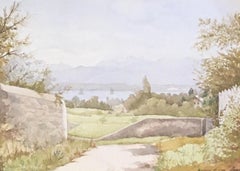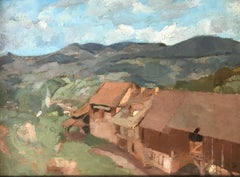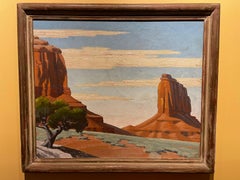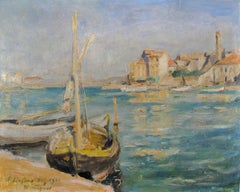Frédéric Dufaux Art
Swiss, 1852-1943
Auguste Frédéric Dufaux is a Swiss painter born in Geneva on July 12, 1852, died in the same city on July 2, 1943.
He comes from a family of enamel painters and enamel makers. Descendant of French Huguenots hunted by the Edict of Nantes, his father, Frédéric Guillaume Dufaux, painter and sculptor, gave him his first drawing lessons, then he enrolled at the School of Fine Arts in Geneva where he met his teacher, Barthélemy Menn.
He continued his studies in Paris and Florence at the Uffizi Academy where he worked with Luigi Rubio, Italian painter of history and portrait painter.
According to his son, Henri Dufaux, he is a hard worker. He produces portraits and specializes in genre subjects and intimate landscapes that he exhibits regularly. He lived in Paris from 1876 to 1891 and participated in the Salon of French artists. He travels to Italy, Algeria, Egypt, from where a certain number of exotic works.
He participates with Édouard Castres in the panorama The entry of the French army in Verrières. He executed four panels representing the Four Seasons for the Grand Théâtre (Geneva). At the request of Gustave Revilliod, he produced painted boxes (mythological and allegorical scenes) for the ceilings of the Ariana Museum. In this museum are a Portrait of Gustave Revilliod (at the age of 70) by Frédéric Duffaux, as well as a Bust of Ariane Revilliod-De La Rive made by his father, Frédéric Guillaume Dufaux.
In sculpture, he produces busts of François Diday (Rath Museum in Geneva), of Jean-Jacques Rousseau (Grand Théâtre (Geneva)), of Marc Monnier (for the University of Geneva), of Jean-Etienne Dufour (Cimetière des Kings).
His wife Noémie de Rochefort-Luçay, daughter of Henri Rochefort, French writer and politician, gave him three children including Amélie (1878-1948), Geneva's first racing pilot, and the famous aviation pioneers Henri Dufaux and Armand Dufaux. He made the death bust for his father-in-law's grave located in the Montmartre cemetery in Paris.
He practices physical culture and is interested in new inventions (automobile, aviation)
(Biography provided by Gijsel Gallery)
to
1
2
2
1
1
2
Overall Height
to
Overall Width
to
1
1
1
1
2
1
1
2
6,958
3,331
2,514
1,213
2
1
1
Artist: Frédéric Dufaux
Overview of Commugny, Switzerland
By Frédéric Dufaux
Located in Genève, GE
Work on paper
Plexiglass front and back of the work
48 x 41 x 6 cm
Recipe on the back of the work written by the artist's hand
Category
Early 1900s Frédéric Dufaux Art
Materials
Watercolor
"Geneva countryside" by Frédéric Dufaux - Oil on wood
By Frédéric Dufaux
Located in Geneva, CH
Work on cardboard
Gilded wood frame
35 x 43,5 x 4 cm
Category
1940s Modern Frédéric Dufaux Art
Materials
Oil
Related Items
OIL BOAT
By Arthur Dove
Located in Portland, ME
Dove, Arthur (American, 1880-1946). OIL BOAT. Watercolor and crayon on paper, 1932. Signed "Dove," lower right. Provenance, Alfred Stieglitz, American Place Gallery; Terry Dintenfass...
Category
1930s Frédéric Dufaux Art
Materials
Watercolor, Crayon
Vintage Modernist Landscape Painting, Monument Valley Arizona, listed artist
Located in Baltimore, MD
Although born in Ohio at the end of the 19th century, Martin Sabransky studied art at Randolph Macon College in Virginia. He began his career path moving west, by first going to Kans...
Category
Mid-20th Century American Modern Frédéric Dufaux Art
Materials
Oil
Untitled (Farm in Winter)
By Julius M. Delbos
Located in Los Angeles, CA
This work is part of our exhibition America Coast to Coast: Artists of the 1940s
Untitled (Farm in Winter), 1940s, oil on canvas, signed lower right, 26 x 30 inches, presented in an original frame
Julius Delbos...
Category
1940s American Modern Frédéric Dufaux Art
Materials
Canvas, Oil
Landscape
By Marcel Emile Cailliet
Located in Los Angeles, CA
Landscape, 1940, oil on canvas, 24 x 20 inches, signed, dated and titled verso: “Marcel Cailliet ’40 – S.C.” and “Marcel Cailliet Landscape”; likely exhibited at the annual juried st...
Category
1940s American Modern Frédéric Dufaux Art
Materials
Canvas, Oil
My Only Working Tool
Located in Los Angeles, CA
My Only Working Tool, 1949, oil on panel, signed and dated lower right, 16 x 12 inches, remnant of exhibition label verso, exhibited at the Art News Second Annual National Amateur Co...
Category
1940s American Modern Frédéric Dufaux Art
Materials
Oil, Board
New York City
By Mykola Krychevsky
Located in Bayonne, NJ
This is a rare watercolor by Mykola Krychevsky - his first impressions when he arrived to New York in 1955. It is possible that this is the skyline he saw from Empire State Building....
Category
1950s Modern Frédéric Dufaux Art
Materials
Watercolor
Untitled (Collapsed Shacks)
By Karl Fortress
Located in Los Angeles, CA
Untitled (Collapsed Shacks), c. 1940s, oil on canvas, signed lower left, 20 ½ x 26 ½ inches, presented in a period frame
This work is part of our exhibition America Coast to Coast: ...
Category
1940s American Modern Frédéric Dufaux Art
Materials
Canvas, Oil
'Les Alyscamps Arles' by Yves Brayer, Large Watercolour Painting
By Yves Brayer
Located in London, GB
'Les Alyscamps Arles', watercolour on art paper, by Yves Brayer (1977). This term has its origins and is related to the Elysian Fields, also called Elysium, which is the final restin...
Category
1970s Frédéric Dufaux Art
Materials
Watercolor, Paper
Figurative landscape oil painting- Purple Memory
Located in Beijing, CN
Dai Xiangwen was born in Hunan in 1991 and graduated from the Academy of Fine Arts of Jianghan University,
He is a member of China Artists Association, China Designers Association, a painter of Li Keran...
Category
2010s Modern Frédéric Dufaux Art
Materials
Canvas, Oil
Free Shipping
H 23.63 in W 31.5 in
Group Of Houses By Edward Hopper
By Edward Hopper
Located in New Orleans, LA
Edward Hopper
1882-1967 American
Group of Houses
Signed “Edward Hopper” (lower right)
Watercolor and pencil on paper
Edward Hopper is unparalleled in his depiction of the America...
Category
20th Century Frédéric Dufaux Art
Materials
Paper, Watercolor, Pencil
View of the Ovo Castle in the Moonlight, a 19th century Neapolitan gouache
Located in PARIS, FR
Neapolitan gouaches appeared in the eighteenth century when tourism in the Naples area was developing: the discoveries of Herculaneum and Pompeii made this city a mandatory stop on the Grand Tour, the journey made by wealthy Europeans to complete their education.
Generally small in size for ease of transport and affordable in price, these gouaches were the ideal travel souvenir that these tourists of the early days were bringing back to capture the idyllic landscapes they had discovered during their journey and to share them with family and friends upon their return at home.
The Bay of Naples and the eruptions of Vesuvius are the favourite themes of these views. Here we have a view of the Ovo Castle, which was rebuilt on the island of Partenope, in the middle of the Bay of Naples and about a hundred metres from the shore by the Normans in the 12th century on antique ruins...
Category
Early 19th Century Romantic Frédéric Dufaux Art
Materials
Gouache, Paper
San Pedro Harbor
By Paul Sample
Located in New York, NY
It is infrequent, to say the least, that a diagnosis of tuberculosis proves fortuitous, but that was the event, in 1921, that set Paul Starrett Sample on the road to becoming a professional artist. (The best source for an overview of Sample’s life and oeuvre remains Paul Sample: Painter of the American Scene, exhib. cat., [Hanover, New Hampshire: Hood Museum of Art, 1988] with a detailed and definitive chronology by Sample scholar, Paula F. Glick, and an essay by Robert L. McGrath. It is the source for this essay unless otherwise indicated.) Sample, born in Louisville, Kentucky, in 1896 to a construction engineer and his wife, spent his childhood moving with his family to the various locations that his father’s work took them. By 1911, the family had landed in Glencoe, Illinois, settling long enough for Paul to graduate from New Trier High School in 1916. Sample enrolled at Dartmouth College, in Hanover, New Hampshire, where his interests were anything but academic. His enthusiasms included the football and basketball teams, boxing, pledging at a fraternity, and learning to play the saxophone. After the United States entered World War I, Sample, to his family’s dismay, signed on for the Naval Reserve, leading directly to a hiatus from Dartmouth. In 1918 and 1919, Sample served in the U.S. Merchant Marine where he earned a third mate’s license and seriously contemplated life as a sailor. Acceding to parental pressure, he returned to Dartmouth, graduating in 1921. Sample’s undergraduate life revolved around sports and a jazz band he formed with his brother, Donald, two years younger and also a Dartmouth student. In November 1933, Sample summarized his life in a letter he wrote introducing himself to Frederick Newlin Price, founder of Ferargil Galleries, who would become his New York art dealer. The artist characterized his undergraduate years as spent “wasting my time intensively.” He told Price that that “I took an art appreciation course and slept thru it every day” (Ferargil Galleries Records, circa 1900–63, Archives of American Art, Smithsonian Institution, available on line).
In 1920, Donald Sample contracted tuberculosis. He went for treatment to the world-famous Trudeau Sanitorium at Saranac Lake, in New York State’s Adirondack Mountains for the prescribed regimen of rest, healthful food, and fresh air. Visiting his brother in 1921, Paul also contracted the disease. Tuberculosis is highly contagious, and had no certain cure before the development of streptomycin in 1946. Even for patients who appeared to have recovered, there was a significant rate of recurrence. Thus, in his letter to Price, Sample avoided the stigma conjured by naming the disease, but wrote “I had a relapse with a bad lung and spent the next four years hospitalized in Saranac Lake.” The stringent physical restrictions imposed by adherence to “the cure” required Sample to cultivate an alternate set of interests. He read voraciously and, at the suggestion of his physician, contacted the husband of a fellow patient for instruction in art. That artist, then living in Saranac, was Jonas Lie (1880–1940), a prominent Norwegian-American painter and an associate academician at the National Academy of Design. Lie had gained renown for his dramatic 1913 series of paintings documenting the construction of the Panama Canal (The Metropolitan Museum of Art, New York; United States Military Academy, West Point, New York). Primarily a landscape artist, Lie had a particular affinity for scenes with water. His paintings, impressionistic, atmospheric, and brushy, never strayed from a realistic rendering of his subject. Sample regarded Lie as a mentor and retained a lifelong reverence for his teacher. Sample’s early paintings very much reflect Lie’s influence.
`
In 1925, “cured,” Sample left Saranac Lake for what proved to be a brief stay in New York City, where his veteran’s benefits financed a commercial art course. The family, however, had moved to California, in the futile hope that the climate would benefit Donald. Sample joined them and after Donald’s death, remained in California, taking classes at the Otis Art Institute in Los Angeles. In Sample’s account to Price, “I couldn’t stomach the practice of painting a lot of High Sierras and desert flowers which seemed to be the only kind of pictures that were sold here so I got a job teaching drawing and painting at the art school of the University of Southern California.” Initially hired as a part-time instructor, Sample progressed to full-time status and ultimately, by the mid-1930s, to the post of Chairman of the Fine Art Department. Sample, however, did not want to wind up as a professor. “Teaching is all right in small doses,” he wrote, “but I have a horror of drifting into being a college professor and nothing more.” At the same time as he taught, Sample began to exhibit his work in a variety of venues at first locally, then nationally. Though he confessed himself “a terrible salesman,” and though occupied with continued learning and teaching, Sample was nonetheless, ambitious. In 1927, he wrote in his diary, “I am eventually going to be a painter and a damned good one. And what is more, I am going to make money at it” (as quoted by Glick, p. 15). In 1928, Sample felt sufficiently solvent to marry his long-time love, Sylvia Howland, who had also been a patient at Saranac Lake. The Howland family were rooted New Englanders and in summertime the Samples regularly traveled East for family reunion vacations.
While the 1930s brought serious hardship to many artists, for Paul Sample it was a decade of success. Buttressed by the financial safety net of his teacher’s salary, he painted realist depictions of the American scene. While his work addressed depression-era conditions with a sympathetic eye, Sample avoided the anger and tinge of bitterness that characterized much contemporary realist art. Beginning in 1930, Sample began to exhibit regularly in juried exhibitions at important national venues, garnering prizes along the way. In 1930, Inner Harbor won an honorable mention in the Annual Exhibition of the Art Institute of Chicago. That same year Sample was also represented in a show at the Albright-Knox Gallery in Buffalo and at the Biennial Exhibition of the Corcoran Gallery of Art, Washington, D.C. In 1931, Dairy Ranch won the second Hallgarten Prize at the Annual Exhibition of the National Academy of Design, in New York. Sample also made his first appearances at the Carnegie Institute, Pittsburgh, and The Pennsylvania Academy of the Fine Arts, Philadelphia. In 1936, Miner’s Resting won the Temple Gold Medal at the Pennsylvania Academy’s Annual Exhibition. Always interested in watercolor, in 1936, Sample began to send works on paper to exhibitions at the Whitney Museum, New York.
While participating in juried exhibitions, Sample also cultivated commercial possibilities. His first New York art dealer was the prestigious Macbeth Gallery in New York, which included his work in a November 1931 exhibition. In 1934, Sample joined the Ferargil Galleries in New York, after Fred Price arranged the sale of Sample’s Church Supper to the Michele and Donald D’Amour Museum of Fine Arts in Springfield, Massachusetts. In 1937, The Metropolitan Museum of Art purchased Sample’s Janitor’s Holiday from the annual exhibition of the National Academy of Design, a notable honor.
As prestigious as this exhibition schedule may have been, by far Sample’s most visible presence in the 1930s and 1940s was the result of his relationship with Henry Luce’s burgeoning publishing empire, Time, Inc. Sample’s first contribution to a Luce publication appears to have been another San Pedro...
Category
20th Century American Modern Frédéric Dufaux Art
Materials
Canvas, Oil
Previously Available Items
Oil Painting of the Harbour of Martigues in France on a Sunny August Day
By Frédéric Dufaux
Located in Meinisberg, CH
Frédéric Dufaux
(Swiss, 1852-1943)
The Harbour of Martigues in France in Sunny August
Plein Air Oil on light card, ca. 19 x 24 cm
Heavy card mount in an unglased frame, ca. 37 x 42 cm
Signed into the wet paint, titled ' Martigues ' and dated 31. 8. 1931 lower left
Auguste Frédéric Dufaux was born 1852 in Geneva, Switzerland into an artistic family of French Huguenots. His father, Frédéric Guillaume Dufaux, respected painter and sculptor, gave him his first drawing lessons, then he enrolled at the School of Fine Arts of Geneva.
For his further studies he traveled to Italy, where he worked at the Uffizi Academy in Florence and to Paris in France, where he married, settled and started a family.
He lived and worked in Paris from 1876 to 1891, participated in the Salon of French artists and travelled to paint in southern Europe and North Africa.
In sculpture, he produced the noted busts of François Diday...
Category
1930s Impressionist Frédéric Dufaux Art
Materials
Oil, Cardboard
Free Shipping
H 14.57 in W 16.54 in D 1.19 in
"Geneva countryside" by Frédéric Dufaux - Oil on wood
By Frédéric Dufaux
Located in Geneva, CH
Work on cardboard
Gilded wood frame
35 x 43,5 x 4 cm
Category
1940s Modern Frédéric Dufaux Art
Materials
Oil
H 10.24 in W 13.78 in D 0.4 in
Frédéric Dufaux art for sale on 1stDibs.
Find a wide variety of authentic Frédéric Dufaux art available for sale on 1stDibs. You can also browse by medium to find art by Frédéric Dufaux in paint, oil paint, watercolor and more. Much of the original work by this artist or collective was created during the 20th century and is mostly associated with the modern style. Not every interior allows for large Frédéric Dufaux art, so small editions measuring 9 inches across are available. Frédéric Dufaux art prices can differ depending upon medium, time period and other attributes. On 1stDibs, the price for these items starts at $1,020 and tops out at $1,031, while the average work can sell for $1,025.




